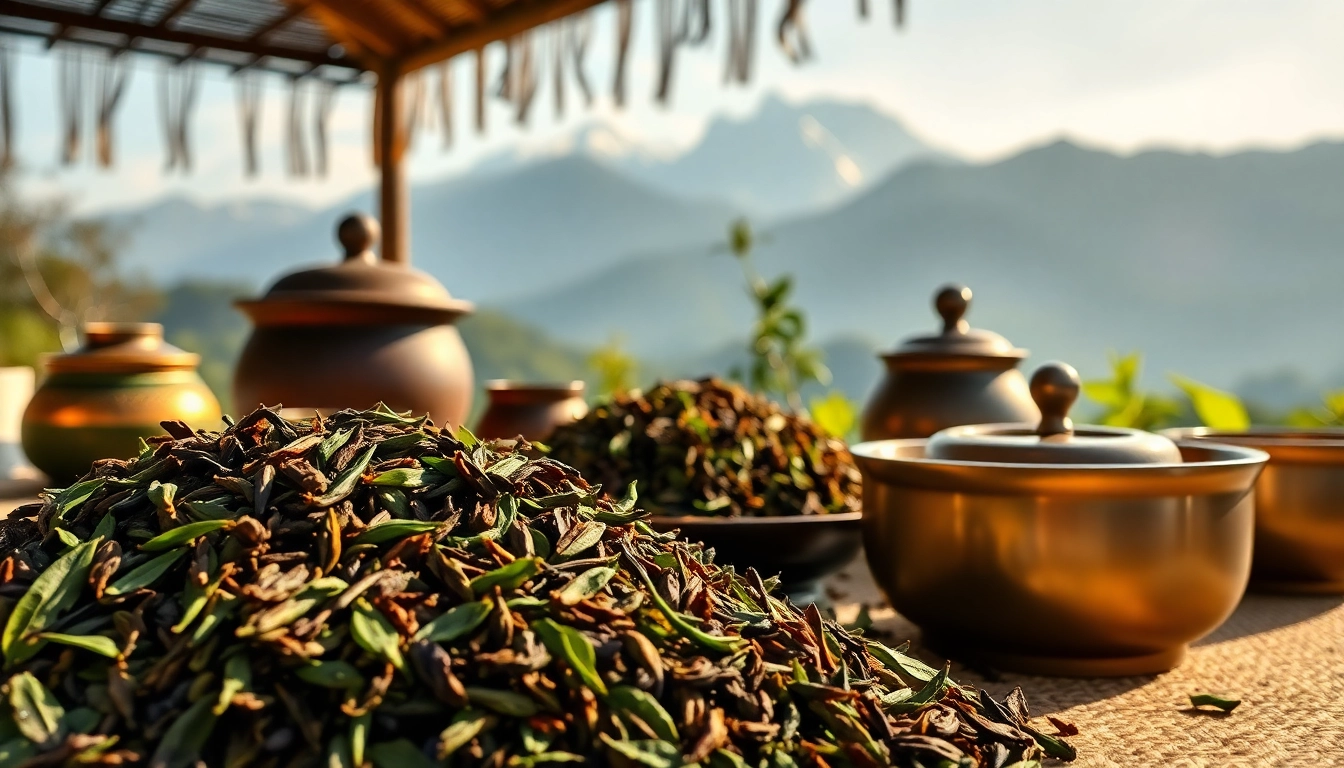Introduction to Nepali Tea: A Cultural Heritage
Nepali tea is much more than just a beverage; it represents centuries of tradition and the rich cultural heritage of the land it originates from. Grown in the majestic Himalayas, these teas are known for their unique flavors and aromatic qualities. The combination of altitude and local practices results in products that are both distinctive and comparable to renowned varieties like Darjeeling tea, produced just across the border in India. The journey of Nepali tea reflects the exquisite landscapes, diligent hands behind its cultivation, and the cultural practices surrounding its enjoyment. For tea enthusiasts worldwide, exploring Nepali tea offers an invitation to connect with a rich legacy and remarkable taste.
The Origins and History of Nepali Tea
The origins of tea in Nepal date back to the late 19th century when it was introduced by the British in Darjeeling. The climate and soil conditions in the hilly regions of Nepal proved conducive for tea cultivation, leading to the establishment of commercial tea estates. The key areas for tea production include Ilam, Dhankuta, and Panchthar, where the leafy gems are nurtured under Himalayan weather conditions. Over the years, Nepali tea has evolved, with local farmers adopting organic farming practices, making it a favorite among health-conscious consumers.
Key Characteristics of Nepali Tea Varieties
Nepali tea encompasses a diverse range of varieties, including black, green, white, and oolong teas. Each type boasts distinct characteristics shaped by factors such as altitude, soil type, leaf processing, and climate. For instance, black Nepali tea is renowned for its robust flavor and rich color, often having muscatel notes that enthusiasts appreciate. Green Nepali tea provides a refreshing alternative, characterized by its grassy notes and delicate sweetness. These variations enhance the artistic depth of Nepali tea, capturing the essence of the landscape where they are grown.
Cultural Significance of Tea in Nepal
In Nepal, tea plays a central role in social customs and daily life. It serves as a comforting beverage during gatherings and ceremonial events, reflecting the hospitality of the Nepali people. Traditionally, tea is often brewed with spices and milk, creating a version known as chiya, showcasing the local flavor profile. The act of sharing tea fosters community bonds, celebrating unity and friendship. Moreover, tea cultivation provides livelihoods for many families, retaining cultural practices and sustaining local economies.
Types of Nepali Tea: A Bouquet of Flavors
Black Nepali Tea: Bold and Robust Profiles
Black Nepali tea is among the most sought-after varieties, appreciated for its deep flavors and complexity. The leaves are typically harvested during the first and second flushes, leading to a unique taste. From the scenic tea gardens of Ilam, these teas are meticulously handpicked and processed. The aroma is often reminiscent of floral and fruity notes, while the infusion offers a robust and malty flavor. With each sip, one can experience hints of muscatel—a flavor prized by connoisseurs, drawing them closer to the high-altitude origins of these leaves.
Green Nepali Tea: Fresh and Invigorating Notes
Green tea from Nepal is celebrated for its refreshing and invigorating qualities, targeted toward those who appreciate a lighter beverage. The tea leaves are minimally oxidized, preserving their vibrant green color and natural antioxidants. As you steep Nepali green tea, it releases fragrant aromas and subtle grassy notes. It’s a delightful choice for health-conscious individuals seeking a flavorful yet nourishing beverage that aligns with modern wellness trends.
Specialty Teas: Unique Brews from the Himalayas
Beyond traditional black and green teas, Nepal also offers a variety of specialty teas that reflect the region’s unique terroir. These include white teas, which are handpicked and delicately processed for a light and sweet flavor, and oolong teas, which are semi-oxidized and combine elements of black and green tea, resulting in a complex flavor profile. Each specialty tea tells a different story, capturing the essence of the Himalayan landscapes and traditional growing practices.
Health Benefits of Nepali Tea: Why It’s Good for You
Nutritional Content of Nepali Tea
The health benefits of Nepali tea stem from its rich nutritional profile. Packed with antioxidants, flavonoids, and polyphenols, these teas support good health by combating free radicals and promoting various bodily functions. Regular consumption can improve heart health, boost metabolism, and enhance mental clarity. Each variety boasts its unique benefits; for example, green tea is known for its metabolism-boosting properties, while black tea can support gut health and improve digestion.
Traditional Uses in Ayurvedic Practices
You’ll find that tea is an integral part of Ayurvedic practices in Nepal, where it is revered not just for its taste but also for its therapeutic properties. Herb-infused brews often utilize local ingredients like ginger, cardamom, and turmeric, believed to aid digestion and restore balance in the body. Chiya, the spiced milk tea, is particularly popular in households, known for warming the body and promoting comfort during cold seasons.
Modern Scientific Insights on Health Benefits
Scientific studies have begun to validate many of the traditional claims surrounding the health benefits of tea. Research highlights that the antioxidants found in Nepali black and green tea may lower the risk of chronic diseases, including diabetes and heart conditions. Moreover, the calming properties of tea can reduce stress and anxiety, offering both physical and mental health benefits, making it an excellent addition to a wellness routine.
How to Brew the Perfect Cup of Nepali Tea
Brewing Techniques for Different Tea Types
Brew time and temperature play significant roles in extracting the ideal flavors from Nepali teas. For black tea, water temperature between 200°F to 212°F (93°C – 100°C) is ideal, and the steeping time should range from 3 to 5 minutes for optimal flavor. Green tea, on the other hand, requires cooler water at about 175°F to 185°F (80°C – 85°C) and should be steeped for 2 to 3 minutes to prevent bitterness. Tailoring the brewing process ensures that each cup delivers the full character of the tea.
Tools and Equipment for Tea Preparation
When brewing Nepali tea, the right tools enhance the experience. A teapot or a gaiwan can be used for steeping, and using a fine mesh strainer will ensure no leaves enter your cup. For those who prefer loose leaf teas, investing in a tea infuser can make the brewing process more straightforward. Additionally, a thermometer ensures that the water temperature is just right for the specific tea type, enhancing flavor extraction significantly.
Flavor Pairing and Enhancements for Nepali Tea
To elevate the tea-drinking experience, consider flavor pairing. Black Nepali tea pairs beautifully with a touch of honey or a slice of lemon, enhancing the drink’s natural sweetness. Green tea, when enjoyed with light snacks like nuts or fruits, can provide a refreshing and balanced experience. For those interested in experimenting, adding spices like cinnamon, cardamom, or fresh ginger can create unique, aromatic blends that simultaneously celebrate Nepali culture and elevate your palate.
Where to Buy Authentic Nepali Tea Online
Best Online Retailers for Nepali Tea
As the popularity of Nepali tea has grown globally, several online retailers now specialize in providing authentic products sourced directly from Nepali farms. Websites like the Nepali Tea Traders, Nepal Tea Collective, and Upton Tea Imports offer an impressive variety of organic and specialty teas, making it easier for enthusiasts to access these unique flavors from anywhere. Reading reviews and researching each vendor can help ensure the quality of your purchase.
Understanding Pricing and Quality Indicators
When purchasing Nepali tea online, it’s vital to evaluate pricing in relation to quality. Authentic and organic teas may be priced higher than mass-produced varieties but are worth the investment for their freshness and flavor. Look for indicators such as the origin of tea, certification labels, and descriptions that highlight the specific types of leaves used in their blends. Investing in higher-quality teas not only benefits your palate but also supports ethical farming practices.
Supporting Local Nepali Tea Farmers: Ethical Choices
One can make a significant impact by choosing to buy from retailers that support local Nepali tea farmers. These purchases contribute to sustainable agricultural practices and fair trade initiatives that support communities in growing regions. By prioritizing brands that promote ethical sourcing, consumers not only enjoy excellent tea but also help improve the livelihoods of farmers and their families, fostering more sustainable and equitable tea production in Nepal.



